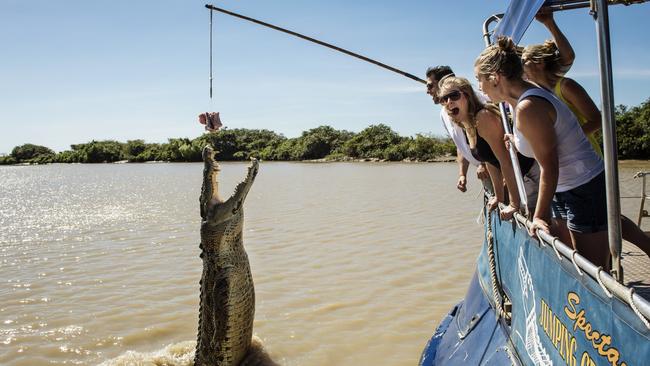Third year of La Nina set to spoil east coast summer holiday plans
The likelihood of a third year of La Nina has east coast tourism operators worried as the NT and WA look to lure holiday-makers away.

A third year of La Nina weather chaos is taking a toll on summer holiday plans with research finding up to two-thirds of Australians are rethinking their end-of-year getaway.
With the east coast set to cop another drenching, a study commissioned by Tourism Northern Territory found 62 per cent of those surveyed were looking at a Spring-time break to avoid the disruption of recent years.
The Decibel Research survey of almost 2000 people aged 18 and over, found 84 per cent felt their ability to enjoy summer had been impacted over the last few years due to Covid-19, bushfires and floods.
With Queensland’s traditional holiday hot spots in the firing line of La Nina, Queensland Tourism Industry Council CEO Brett Fraser said there was much concern about the forecast.
He said like many industries the tourism sector was still recovering from the challenges of the last three years, and any new challenges would have operators on alert.
“The success of our visitor economy relies on certainty and stability (and) extreme fluctuations in weather conditions are far from ideal,” Mr Fraser said.
“For now our industry will remain alert but not alarmed at the forecasts and we’ll continue to monitor the situation closely.”
The east coast’s pain could prove to be the Top End’s gain, with Tourism NT encouraged by the finding that 67 per cent of respondents were willing to consider trading their usual summer holiday destination for somewhere with comparable conditions.
Tourism NT executive director of marketing Tony Quarnby said with warm summer-like conditions throughout September and October, the Top End was well placed to benefit.
“Over the last few years it was Covid restrictions that caused the most disruption to holiday plans with the research finding 65 per cent of those surveyed didn’t bother going away,” Mr Quarnby said.

“Now it’s the weather that’s the big factor in summer holiday planning so we’re encouraging people to think more flexibly about summer getaways.”
Western Australia was also angling to take advantage of any east coast weather woes, with the state expecting a much drier end to the year.
Tourism Council of WA CEO Evan Hall said Perth had the most days of sunshine of any capital city and south coast beaches boasted “more kangaroos than Sydneysiders”.
“We are expecting to get more people coming over from the east coast this spring and summer to enjoy our warm and dry conditions,” Mr Hall said.
“The beaches around Margaret River, Albany and Esperance will be very popular and you can fly straight into Margaret River now at Busselton Airport.”
It appeared domestic tourism would continue to be the main fodder for tourism operators with a continuing disparity between outbound and inbound travellers.
Bureau of Statistics data for June showed 621,300 Australians headed overseas for a short-term trip in the month, more than double the number of short-term international arrivals at 275,300.

Australian Federation of Travel Agents CEO Dean Long said the softness in international visitors down under was apparent all the way through to the end of the year.
“Normally before Christmas we get a lot of people coming from Europe but that isn’t in play at the moment, those forward bookings aren’t there,” Mr Long said.
“We’d normally have much more business on the books.”
Outbound travel was a different story with strong demand continuing from the visiting family and friends and corporate markets, said Mr Long.
“The only thing that’s stopping outbound demand at the moment is the lack of flights and the lack of cruise ships,” he said.
“We could sell more if the supply was there, and we’re yet to see the full recovery of the leisure market as a consequence of the cost of airfares in the market.”




To join the conversation, please log in. Don't have an account? Register
Join the conversation, you are commenting as Logout